 Discoveries
So Far
Discoveries
So Far
Sector 2
The sector under excavation adjacent to the kirkyard (the glebefield) was first contacted during evaluation in 1996. A complex sequence of pits, gullies and a metalled road were discovered. The area falls within the T-shaped sample and has been under investigation since 1996.
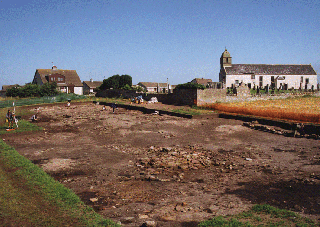
Excavation of the Glebe Field.
The sequence encountered consists of a medieval phase of activity comprising domestic and industrial occupation. Metal-working hearths and signs of iron smelting and smithing are abundant. Artefacts retrieved such as spindle whorls, coins and pottery hint at more domestic occupation.
Underneath this horizon of activity lies the focus of our investigations. The workshops producing bronze, silver and gold objects, wooden items, fine leather goods and decorative glass objects that belong to the monastery at Tarbat lie here. (To see some of these objects, go to the finds section.) The deposits are very complex and deeply stratified as an excavation in advance of a below-ground oil tank showed.
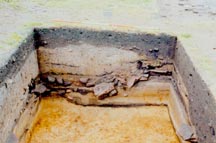
Click to view larger image of domestic and industrial section occupation.
The organisation of space is dominated by a stone-kerbed and slab-surfaced road that runs through the area of investigation.
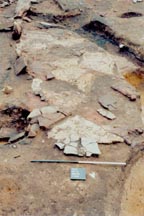
Click to view larger image of slab surfaced road.
To either side of the road are several workshops which are betrayed by a possibly central stone-lined hearth. Their walls are very difficult to define confidently and they may well have been made of turf and timber. These are all situated on a man-made terrace which raises the industrial area above the water of the possible millpond. Each workshop is engaged in specific activities. The deposits in the workshops represent industrial activity over years and possibly decades making the archaeology very complex. To the east of the road, a workshop sat on the terrace-edge is producing objects such as ingots, rings and creuset lamps with cast or hammered metals. Bronze trapped in crucibles and a tray for separating gold and silver hint at some of the metals used.
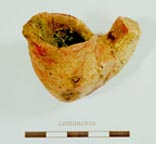
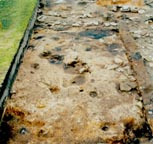
Click to view larger image of bronze working crucible and leatherworking workshop excavation.
A fragment of heating tray with bright yellow glass adhering to it demonstrates that these artisans could work with a variety of materials using similar techniques. To the west of the road another workshop is engaging in activities which do not exploit heat. Leather and wood-working seem to be the focus of activity here. Perhaps the crafts were kept apart deliberately to avoid unnecessary fire risk. Link to finds report. Mysterious rows of cow metapodial bones are pushed into the ground in V-shaped formations. It seems likely that they were used to process leather in some way.
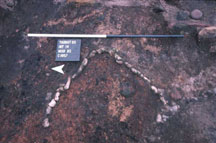
Click to view larger image of v-shaped formation.
Beyond the terrace walls a large expanse of the site is given over to a possible millpond. Various stone-lined culverts are thought to belong to engineering of the water in order to power a millwheel. The millpond would have been fed by an under ground stream which runs into the site from the east. A water mill would have added further strength and influence to the monastery and it would be easily compared to the millstream within the monastic enclosure at Iona.
Last updated 10 October, 2003.
Contact the Tarbat Discovery Programme


